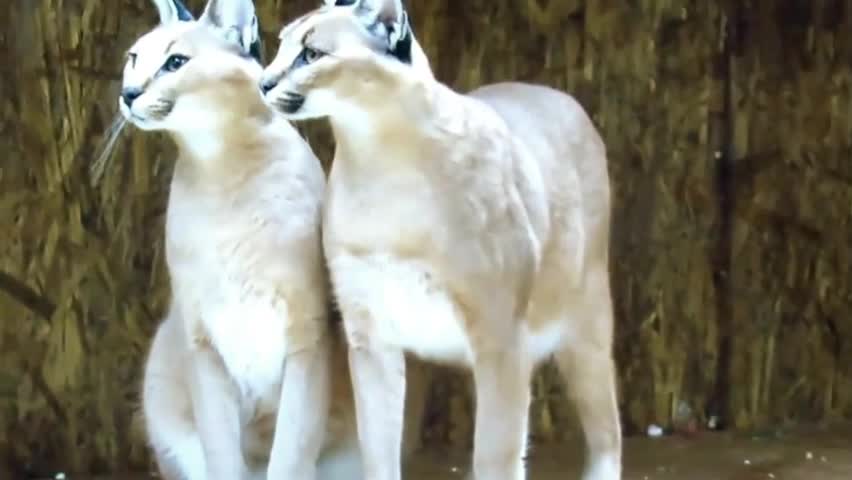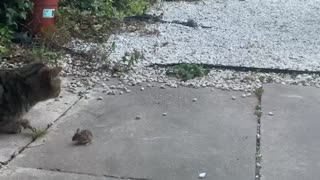Premium Only Content

watch this Caracal Wild Cat
watch this Caracal Wild Cat
The #caracal (Caracal caracal) is a medium-sized #wild #cat native to Africa, the Middle East, Central Asia and India. The caracal is characterized by a robust build, long legs, a short face, long tufted ears and long canine teeth. Its coat is uniformly reddish tan or sandy, while the ventral parts are lighter with small reddish markings. It reaches 40–50 cm (16–20 in) at the shoulder and weighs 8–18 kg (18–40 lb). It was first scientifically described by German naturalist Johann Christian Daniel von Schreber in 1777. Eight subspecies are recognised.
Typically nocturnal, the caracal is highly secretive and difficult to observe. It is territorial, and lives mainly alone or in pairs. The caracal is a carnivore that typically preys upon small mammals, birds and rodents. It can leap higher than 3 m (9.8 ft) and catch birds in mid-air. It stalks its prey until it is within 5 m (16 ft) of it, after which it runs it down, the prey being killed by a bite to the throat or to the back of the neck. Breeding takes place throughout the year with both sexes becoming sexually mature by the time they are a year old. Gestation lasts between two and three months, resulting in a litter of one to six kittens. Juveniles leave their mothers at nine to ten months, though a few females stay back with their mothers. The average lifespan of the caracal in captivity is nearly 16 years.
The caracal is a slender, moderately sized cat characterised by a robust build, a short face, long canine teeth, tufted ears, and long legs. It reaches nearly 40–50 centimetres (16–20 in) at the shoulder; the head-and-body length is typically 78 centimetres (31 in) for males and 73 centimetres (29 in) for females. While males weigh 12–18 kilograms (26–40 lb), females weigh 8–13 kilograms (18–29 lb). The tan, bushy tail measures 26–34 centimetres (10–13 in), and extends to the hocks. The caracal is sexually dimorphic; the females are smaller than the males in most bodily parameters.
The prominent facial features include the 4.5 centimetres (1.8 in) long black tufts on the ears, two black stripes from the forehead to the nose, the black outline of the mouth, the distinctive black facial markings, and the white patches surrounding the eyes and the mouth. The eyes appear to be narrowly open due to the lowered upper eyelid, probably an adaptation to shield the eyes from the sun's glare. The ear tufts may start drooping as the animal ages. The coat is uniformly reddish tan or sandy, though black caracals are also known. The underbelly and the insides of the legs are lighter, often with small reddish markings. The fur, soft, short and dense, grows coarser in the summer. The ground hairs (the basal layer of hair covering the coat) are denser in winter than in summer. The length of the guard hairs (the hair extending above the ground hairs) can be up to 3 centimetres (1.2 in) long in winter, but shorten to 2 centimetres (0.8 in) in summer. These features indicate the onset of moulting in the hot season, typically in October and November. The hindlegs are longer than the forelegs, so that the body appears to be sloping downward from the rump.
-
 1:55
1:55
RandomCatLife
3 years agoCat punches mouse MUST WATCH!
28 -
 1:43:21
1:43:21
Redacted News
5 hours agoBREAKING! UKRAINE AGREES TO CEASEFIRE WITH RUSSIA... BUT THERE'S A BIG CATCH | Redacted News
137K239 -
 58:17
58:17
Candace Show Podcast
6 hours agoShould We Feel Bad For Blake Lively? | Candace Ep 157
90.8K166 -
 3:06:52
3:06:52
The Nerd Realm
7 hours ago $10.76 earnedHollow Knight Voidheart Edition #19 | Nerd Realm Playthrough
58.1K5 -
 1:17:27
1:17:27
Awaken With JP
9 hours agoThe Current Thing: Tesla Protesting - LIES Ep 82
104K41 -
 1:07:08
1:07:08
Sean Unpaved
6 hours agoNFL Free Agency Rolls On! MLB Spring Training Heats Up along with 3x World Series Champ Dave Stewart
62.7K3 -
 2:10:15
2:10:15
Right Side Broadcasting Network
11 hours agoLIVE REPLAY: White House Press Secretary Karoline Leavitt Holds Press Briefing - 3/11/25
154K42 -
 2:06:00
2:06:00
The Quartering
9 hours agoTrump Goes NUCLEAR On Canada, Blasts Massie, Harry Potter Race Swap, Man Humiliated On TV Show
109K62 -
 1:03:09
1:03:09
The White House
9 hours agoPress Secretary Karoline Leavitt Briefs Members of the Media, Mar. 11, 2025
107K70 -
 1:07:03
1:07:03
Winston Marshall
8 hours agoEXCLUSIVE : Oliver Anthony On Life After ‘Rich Men’, The Christian Counter Culture and The Elites
71.1K11